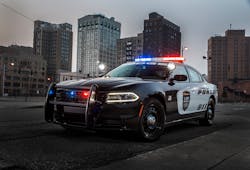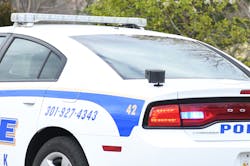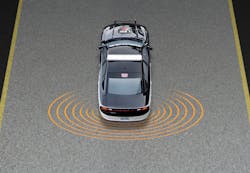Incidents of law enforcement traffic stops turning deadly have become an all too familiar scene along U.S. roadways. Recently, a California Highway Patrol motorcycle officer and a motorist he pulled over were both killed when a pickup truck veered out of its lane and struck the two men. Seven officers have been struck and killed while conducting traffic stops so far this year, according to this year’s mid-year Law Enforcement Officers Fatalities Report. Once more, while overall law enforcement fatalities are decreasing, traffic-related fatalities are on the rise.
Auto makers and high-tech companies are working to arm officers and their vehicles with more technologies designed to actively take steps to elevate protection by reducing distraction.
Keep your eyes up
Though a version of the technology has been around for several years, the newest version of bluePRINT technology from SoundOff Signal is a game changer for law enforcement. bluePRINT is a control system made up of hardware and software that integrates into the officer’s vehicle—the latest version plugs into the OBD to read vehicle speed, seatbelt engagement, and more.
The product creates a safer environment for officers by automating many tasks and decreasing the officer’s decision load. How? The system can be programmed in many ways to use the vehicle’s information and reacts to an officer’s actions. For example, if an officer is driving Code 3 through an intersection, the system can be programmed so that if the officer touches the horn, the light flash pattern and siren changes more rapidly and after six seconds, automatically goes back to where it was. “Under stress, officers can lose fine motor skills, making it very difficult to manipulate small buttons or switches. It’s also very common for officers to experience tunnel vision under stress,” says Chad Wollen, director of business development, emergency vehicle, SoundOff Signal. “With traditional warning equipment, an officer might have to look down to find the right switch or button to activate. This diverts their eyes from the road, much like texting and driving. With our system, all the officer has to do is press the horn ring of the car to make lights change patterns and sirens switch tones. That’s less decisions they have to make and automates what they’re doing, allowing them to just drive.”
The product’s use-cases are infinite and can be customized to the agency’s wants and needs. Do you want the end cap of the light bar to cut out when the officer opens his driver door so he’s not immediately blinded? It can be done. Do you want your siren to turn off automatically once you put the vehicle in park? It can be done. Do you want your light bar brightness to automatically change depending on your speed at night? It can be done.
“Our goal is to enhance officer safety by allowing them to keep their hands on the steering wheel and their eyes on the road,” says Wollen. “With bluePRINT, we program the car to react with what you’re normally doing to help you do your job safer.”
Automated enforcement
Automation helps take some of the tasks away from LEOs, which means they can focus on the important assignments at hand. For officers making routine traffic stops, that means focusing on the driver you pulled over, and worrying less about the traffic zooming by.Earlier this year Brekford Traffic Safety launched the Argos Guardian Move Over Camera designed to watch and identify the distance and speed at which traffic is passing next to a cruiser. There are two versions of the product: An external version that mounts on the rear of a police cruiser or SUV, and an embedded version where the front camera mounts below the mirror with side cameras in the rear quarter panels and radar embedded in the bumper. What both versions do is combine the camera technology with the radar. There are three cameras total—the first is a 180 degree camera which will identify the approaching vehicle as it passes; the second camera is trained on the emergency lights so it shows the officer’s lights were in operation; the third is trained on the rear tag.
The high end tracking radar can track 32 objects simultaneously while an algorithm identifies whether or not there was an open lane for the vehicle to move over. If not, then it tracks the speed—it will pull a 10 second video clip of the infraction coupled with the lights showing them in operation and the tag shot put together in a violation packet. The device is fully automated, says Rod Hillman, CEO, Brekford Traffic Safety, so there is very little interaction officers need to have with it. “It knows when they’ve stopped because of GPS and it knows when their lights are enabled and automatically goes into enforcement mode. When they complete the stop, it shuts down from enforcement mode,” he says. “It’s non-invasive in that we don’t connect to the vehicle’s systems, other than a power feed, either.”
The system includes an artificial intelligence-based ALPR capability that can read and convert tags, and also identify make, model, and color of vehicles, both while stationary as well as while driving. It also is coupled with a robust backend citation management system that tracks and captures citations, deals with payment processing, mailing and more. “The purpose of tools like this ultimately is to improve safety,” says Hillman. The technology is being fine-tuned with agencies right now.
Technology promotes active safety
Police officer ambushes is a threat Fiat Chrysler N.V. is working to reduce, if not eliminate, with its Officer Protection Package. Working with InterMotive Inc., the auto maker has been shipping the easy-to-install modules to law enforcement around the country for use with the auto maker’s Dodge Charger Pusuit.
The protection package has a rear sensor, blind spot and cross path detection. An officer sitting on the side of the road monitoring traffic can push one of three steering wheel buttons and has access to his backup camera. “If you’re sitting there, you can actually see if someone is approaching from the rear,” says David Callery, program manager for police and emergency response vehicles for FCA. “If someone is approaching from the rear, you’ll not only see the subject coming up on the camera, but additionally you’ll get an audible alarm in the car telling you somebody is coming up from behind.”The sensors can also be programmed to automatically close the front windows, lock the doors and flash the taillights to simulate a vehicle being put in reverse. “If that person is coming up to do harm to the officer, maybe those actions alone would cause them to turn around and run away,” says Callery. “It gives an officer possibly a fighting chance if in fact someone is approaching a vehicle from the rear.” Though the technology does not replace situational awareness, it acts as a second set of eyes for the officer and is one more tool in the toolbox. “Really, it’s a connected officer and vehicle,” he notes.
It’s clear that today’s patrol vehicle is not what it was 20 or even 10 years ago. Despite the amount of integrated technology, there is also evidence that manufacturers are working to give officers ample information while decreasing distraction and improving safety.
Increased information at your hands
About the Author

Adrienne Zimmer
Editor
Adrienne Zimmer was the Editor of Law Enforcement Technology magazine, a monthly business-to-business publication that covers technology trends and best practices for public safety managers from 2017 to 2019. LET is part of Officer Media Group, which also publishes Law Enforcement Product News and Officer.com. Adrienne has been in publishing since 2013.


